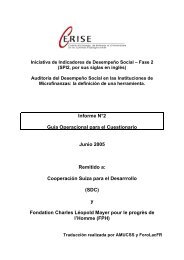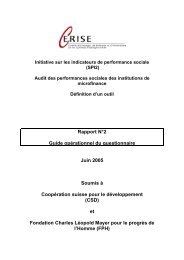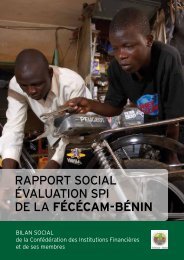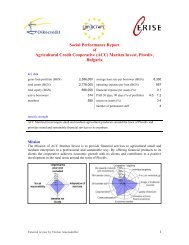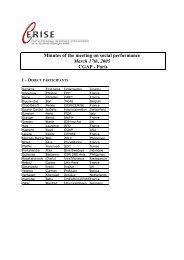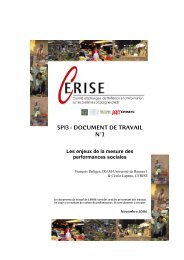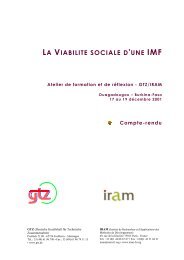Measuring social performance of micro-finance institutions ... - Cerise
Measuring social performance of micro-finance institutions ... - Cerise
Measuring social performance of micro-finance institutions ... - Cerise
Create successful ePaper yourself
Turn your PDF publications into a flip-book with our unique Google optimized e-Paper software.
<strong>Measuring</strong> <strong>social</strong> <strong>performance</strong> <strong>of</strong><br />
<strong>micro</strong>-<strong>finance</strong> <strong>institutions</strong>:<br />
A proposal<br />
Social Performance Indicators Initiative (SPI)<br />
Final Report<br />
Manfred Zeller<br />
University <strong>of</strong> Göttingen, Institute <strong>of</strong> Rural Development, Germany (m.zeller@agr.uni-goettingen.de)<br />
Cécile Lapenu<br />
CERISE, France ; www.cerise-micr<strong>of</strong>inance.org<br />
Martin Greeley<br />
Institute <strong>of</strong> Development Studies, UK; www.ids.ac.uk<br />
October 2003<br />
Submitted to<br />
Argidius Foundation and<br />
Consultative Group to Assist the Poorest (CGAP)
Zeller, Lapenu and Greeley<br />
Summary Report<br />
Social Performance Indicators Initiative (SPI):<br />
Final Report<br />
• Summary Report<br />
Manfred Zeller<br />
Cécile Lapenu<br />
Martin Greeley<br />
1. Background to the SPI........................................................................................................3<br />
2. Definition <strong>of</strong> <strong>social</strong> <strong>performance</strong>s ...................................................................................... 4<br />
2.1 Social <strong>performance</strong> in the literature ........................................................................... 4<br />
2.2 Defining dimensions <strong>of</strong> <strong>social</strong> <strong>performance</strong> with respect to micr<strong>of</strong>inance..................... 5<br />
3. Selection <strong>of</strong> operational indicators <strong>of</strong> <strong>social</strong> <strong>performance</strong>s ............................................... 6<br />
3.1 The steps for the selection.......................................................................................... 6<br />
3.2 The indicators proposed ............................................................................................. 8<br />
Dimension 1: Outreach to the poor and excluded.............................................................. 8<br />
Dimension 2: Adaptation <strong>of</strong> the services and products to the target clients ...................... 9<br />
Dimension 3: Improvement <strong>social</strong> and political capital <strong>of</strong> clients................................... 10<br />
Dimension 4: Social Responsibility <strong>of</strong> the institution...................................................... 11<br />
3.3 Weighting systems proposed.................................................................................... 12<br />
Arbitrary weights.............................................................................................................. 12<br />
Weights given by principle component analysis (PCA) .................................................. 12<br />
3.4 Graphical presentation.............................................................................................. 13<br />
4. Conclusions ...................................................................................................................... 14<br />
The summary report compiles findings <strong>of</strong> the following four complementary reports :<br />
• SPI-Report No. 1: Towards defining <strong>social</strong> <strong>performance</strong> <strong>of</strong> <strong>micro</strong>-<strong>finance</strong> <strong>institutions</strong>:<br />
Literature review and synthesis (Lapenu and Zeller)<br />
• SPI-Report No. 2 : Questionnaire to MFIs on measuring <strong>social</strong> <strong>performance</strong><br />
(Zeller, Lapenu, and Greeley)<br />
• SPI-Report No. 3: Analysis <strong>of</strong> the information provided by <strong>micro</strong> <strong>finance</strong> practitioners<br />
(Lapenu)<br />
• SPI-Report No. 4: Proposal for a limited choice <strong>of</strong> indicators and their aggregation<br />
(Lapenu and Zeller)<br />
Social Performance Indicators Initiative (SPI) 2
Zeller, Lapenu and Greeley<br />
Summary Report<br />
Social Performance Indicators Initiative (SPI)<br />
Summary Report<br />
With the summary report, the research team gives a summary <strong>of</strong> the background, objectives<br />
(i.e. terms <strong>of</strong> reference), activities, and recommendations <strong>of</strong> the Social Performance Indicators<br />
Initiative (SPI).<br />
1. BACKGROUND TO THE SOCIAL PERFORMANCE INDICATOR INITIATIVE<br />
(SPI)<br />
Reporting on <strong>social</strong> <strong>performance</strong> by <strong>micro</strong>-<strong>finance</strong> <strong>institutions</strong> (MFIs) is still largely<br />
anecdotal in the absence <strong>of</strong> a clear, industry-wide, accepted framework for <strong>social</strong> <strong>performance</strong><br />
reporting. It can be seen as a complement to, and on equal footing with, financial <strong>performance</strong><br />
also allowing comparison between peer groups <strong>of</strong> MFIs. In the future one can expect<br />
diminishing resources for development assistance from public donors. At the same time, there<br />
is a growing interest for MicroFinance on the part <strong>of</strong> private <strong>social</strong> investors. In this setting, it<br />
would be important for MFIs to develop the capacities for the simultaneous pursuance <strong>of</strong><br />
financial and <strong>social</strong> objectives, and for reporting on it in a manner which can stand the test <strong>of</strong><br />
external auditing on both accounts. This can also help to improve understanding <strong>of</strong> possible<br />
trade-<strong>of</strong>fs between economic and <strong>social</strong> returns on investment.<br />
Objectives<br />
During its first initial phase, the SPI research project aims to 1 :<br />
(1) Develop a conceptual framework for defining <strong>social</strong> <strong>performance</strong> in the MFI sector,<br />
i.e. what are the dimensions and elements <strong>of</strong> <strong>social</strong> <strong>performance</strong> to be measured?<br />
(2) Suggest a set <strong>of</strong> operational indicators designed to measure the different dimensions<br />
and elements <strong>of</strong> <strong>social</strong> <strong>performance</strong> <strong>of</strong> MFIs.<br />
During a potential second phase, these indicators may be field-tested with a number <strong>of</strong> MFIs<br />
and eventually revised and finalized.<br />
Organization <strong>of</strong> the research project<br />
The Social Performance Indicators Initiative was launched in June 2002 at a meeting in<br />
Amsterdam convened by Dr. Koenraad Verhagen (Argidius Foundation) and Dr. Syed<br />
Hashemi (CGAP). The initiative is supported by the Argidius Foundation. The research<br />
project is administered by CERISE 2 , and CGAP provides the overall coordination.<br />
The SPI is guided by a steering Committee formed by Dr. Syed Hashemi (CGAP, USA), Dr.<br />
Renée Chao Ber<strong>of</strong>f (CIDR/CERISE, France), and Dr. Koenraad Verhagen (Argidius<br />
Foundation, Switzerland).<br />
1 The above objectives are similar to the terms <strong>of</strong> reference.<br />
2 CERISE (Comité d’Echange, de Réflexion et d’Information sur les Systèmes d’Epargne-crédit) is a platform <strong>of</strong><br />
France-based leading Micr<strong>of</strong>inance support organizations (CIDR, CIRAD, GRET and IRAM). CERISE was<br />
started in 1998, and since then it has organized various studies and seminars on the following themes : financing<br />
<strong>of</strong> agriculture, governance, <strong>social</strong> impact, MFIs in remote rural areas, etc. Each CERISE member is part <strong>of</strong> an<br />
extensive network <strong>of</strong> MF practitioners providing MF services in countries <strong>of</strong> the South.<br />
Social Performance Indicators Initiative (SPI) 3
Zeller, Lapenu and Greeley<br />
Summary Report<br />
The research team is formed by Pr<strong>of</strong>. Dr. Manfred Zeller (Team leader – Institute <strong>of</strong> Rural<br />
Development, Göttingen University, Germany), Dr. Martin Greeley (Institute <strong>of</strong> Development<br />
Studies, Manchester UK) and Dr. Cécile Lapenu (CERISE, Paris, France). Members <strong>of</strong> the<br />
research team have already participated in similar initiatives (M. Zeller and C. Lapenu are coauthors<br />
<strong>of</strong> the Poverty Assessment Tool developed for CGAP and M. Greeley is member <strong>of</strong><br />
IMP-ACT project led by IDS and funded by the Ford Foundation).<br />
2. DEFINITION OF SOCIAL PERFORMANCES<br />
The first objective <strong>of</strong> the SPI is to develop a conceptual framework for defining <strong>social</strong><br />
<strong>performance</strong> in the MFI sector, and identify the dimensions and elements <strong>of</strong> <strong>social</strong><br />
<strong>performance</strong> to be measured.<br />
2.1 Social <strong>performance</strong> in the literature<br />
On the basis <strong>of</strong> an extensive review <strong>of</strong> scientific literature, <strong>of</strong> activities <strong>of</strong> the Global reporting<br />
initiative 3 , and <strong>of</strong> a similar project <strong>of</strong> commercial banks seeking to establish a standard to<br />
report on <strong>social</strong> and environmental <strong>performance</strong> in the banking industry, the research team<br />
completed a paper by December 2002 containing a conceptual framework for defining <strong>social</strong><br />
<strong>performance</strong> <strong>of</strong> MFIs (see SPI-report N°1). A narrative definition <strong>of</strong> <strong>social</strong> <strong>performance</strong><br />
synthesized from the literature review is described below.<br />
The <strong>social</strong> <strong>performance</strong> <strong>of</strong> an organization (whether a private-for-pr<strong>of</strong>it firm, cooperative or<br />
NGO) comprises the relations <strong>of</strong> the organization with its clients and with other stakeholder<br />
groups.<br />
Social <strong>performance</strong> is not equal to <strong>social</strong> impact 4 , i.e. the change in welfare and quality <strong>of</strong> life<br />
(in all <strong>of</strong> its dimensions) among clients and non-clients (and the wider local, national and<br />
global community) due to the activities <strong>of</strong> an organization.<br />
Following the Structure-Conduct-Performance (SCP) paradigm <strong>of</strong> industrial organization, the<br />
impact <strong>of</strong> an organization on socio-economic and environmental dimensions follows from its<br />
structure, conduct and <strong>performance</strong> and is influenced and/or conditioned by the external<br />
environment <strong>of</strong> the organization.<br />
3 GRI is an independent institution whose mission is to develop and disseminate globally applicable<br />
Sustainability Reporting Guidelines. It was started in 1997 by the Coalition for Environmentally Responsible<br />
Economies in partnership with the United Nations Environment Program (UNEP).<br />
4 The measurement <strong>of</strong> impact is not part <strong>of</strong> this research project on developing an operational, practitioneroriented<br />
tool for measuring <strong>social</strong> <strong>performance</strong> as part <strong>of</strong> a double-line approach. Social <strong>performance</strong><br />
encompasses poverty outreach but is more than that. For measurement <strong>of</strong> poverty outreach using a relative<br />
measure <strong>of</strong> poverty, operational tools such as the PAT, already exist. The assessment <strong>of</strong> impact is<br />
methodologically very demanding, time- and cost-intensive. Other on-going action-research (IMP-ACT) as well<br />
as long-term policy research projects (e.g. IFPRI, World Bank) deal with assessing the MFIs’ impact on income,<br />
education, nutrition and so forth. While impact assessment is important for policy evaluation, it is not obvious<br />
that it should be done by, with and for the MFI industry as an on-going effort (unless a particular MFI or MFInetwork<br />
wishes to conduct impact analysis on its own). Impact assessments (<strong>of</strong> any policy, organization, or<br />
project) are done infrequently, are externally <strong>finance</strong>d by a donor or external evaluating body, and usually<br />
conducted for reasons <strong>of</strong> objectivity by external consultants with considerable empirical experience in impact<br />
assessment.<br />
Social Performance Indicators Initiative (SPI) 4
Zeller, Lapenu and Greeley<br />
Summary Report<br />
Structure Conduct Performance Impact (on clients/non-clients, communities etc.<br />
in many dimensions)<br />
Thus, <strong>social</strong> (and economic) <strong>performance</strong> precedes <strong>social</strong> (and economic) impact.<br />
The measurement <strong>of</strong> <strong>social</strong> <strong>performance</strong> involves investigating the structure <strong>of</strong> an<br />
organization (i.e. mission, ownership, management principles, relation to and care for its staff)<br />
and its conduct in the market and local and wider community (services, products, market<br />
behavior, other relations with clients and other stakeholders, incl. community and<br />
<strong>social</strong>/political organizations).<br />
In the proposed questionnaire (see report N°4), <strong>social</strong> <strong>performance</strong>s are measured through the<br />
principles, the actions and the corrective measures implemented by the MFI.<br />
2.2 Defining dimensions <strong>of</strong> <strong>social</strong> <strong>performance</strong> with respect to micr<strong>of</strong>inance<br />
Based on the comprehensive literature review, the suggested definition <strong>of</strong> <strong>social</strong> <strong>performance</strong><br />
can be summarized at the outset as follows:<br />
Table 1: Economic and <strong>social</strong> <strong>performance</strong>s and impact for MFIs<br />
Core <strong>social</strong> issues<br />
Economic/financial issues<br />
Performance<br />
monitoring<br />
(intentions and<br />
actions <strong>of</strong> the<br />
MFI)<br />
Global<br />
<strong>performance</strong>s <strong>of</strong><br />
the institution<br />
Impact<br />
assessment<br />
(outcome)<br />
- Outreach to the poor and<br />
excluded: Who are the<br />
clients ?<br />
- Adaptation <strong>of</strong> the services and<br />
products to the target clients<br />
- Social and political capital <strong>of</strong><br />
the clients / Empowerment :<br />
participation in MFI decision<br />
making; “voice” for those<br />
being served to avoid<br />
“mission drift”<br />
- Social responsibility <strong>of</strong> the<br />
MFI; relation with client and<br />
community<br />
- Employment creation for the<br />
excluded population<br />
- Empowerment : position <strong>of</strong><br />
individuals in their family and<br />
communities; <strong>social</strong> capital<br />
building<br />
- Health improvement<br />
- Child education, etc.<br />
- Portfolio quality<br />
- Efficacy and productivity<br />
- Financial management<br />
- Pr<strong>of</strong>itability<br />
- Qualilty and diversity <strong>of</strong><br />
the financial services<br />
<strong>of</strong>fered<br />
- Change in income and<br />
expenditure<br />
- Change in assets and living<br />
standard<br />
- Food security<br />
- Employment creation at<br />
community level<br />
We distinguish four major dimensions <strong>of</strong> <strong>social</strong> <strong>performance</strong> as follows:<br />
1. Outreach to the Poor and Excluded: Mission and Targeting Strategies. MFI have<br />
generally been developed to reach a population excluded from the classical financial<br />
system. MFIs can have the objective <strong>of</strong> reaching <strong>social</strong>ly excluded populations or the<br />
poor, or simply to <strong>of</strong>fer financial services in a region where classical banking systems<br />
are absent. The depth <strong>of</strong> outreach <strong>of</strong> the MFI can be measured to evaluate its focus on<br />
the economically and <strong>social</strong>ly excluded population.<br />
Social Performance Indicators Initiative (SPI) 5
Zeller, Lapenu and Greeley<br />
Summary Report<br />
2. Adaptation <strong>of</strong> the services and products to the target clients. It is not enough to<br />
decide to reach a target population. The MFI must learn about the target population<br />
and work on the design <strong>of</strong> its financial services so that they can fit with the needs and<br />
the constraints <strong>of</strong> the clients. “Pro-poor” services are too <strong>of</strong>ten standardized. Social<br />
<strong>performance</strong> indicators can analyse the process leading to service definition and the<br />
extent to which the MFI knows about its clients’needs.<br />
3. Improving <strong>social</strong> and political capital <strong>of</strong> clients and communities. For the MFI, trust<br />
between the MFI and the clients can reduce the transaction costs and improve<br />
repayment rates. It thus can foster collective action and reduce free-riding,<br />
opportunistic behavior, and reduce risks. For the clients, strengthening their <strong>social</strong> and<br />
political capital can enhance their <strong>social</strong> organization (collective action, information<br />
sharing, political lobbying, etc.). Social <strong>performance</strong> indicators should measure the<br />
degree <strong>of</strong> transparency, the effort <strong>of</strong> the MFI towards giving voice to its clients within<br />
the organisation and beyond (community, local government, national government,<br />
etc.).<br />
4. Social responsibility <strong>of</strong> MFI. Social awareness is a necessary pre-requisite for <strong>social</strong>ly<br />
responsible corporate behavior. Social responsibility requires an adaptation <strong>of</strong> the MFI<br />
corporate culture to their cultural and socio-economic context, an adequate human<br />
resource policy, credit guarantees adapted to the local conditions, and balanced<br />
relationships between staff and clients (in particular in MFIs where there are elected<br />
clients who participate in decision making).<br />
Social <strong>performance</strong>s <strong>of</strong> an MFI rely on these four dimensions. Poverty outreach, shaded in<br />
Table 1, is one among the different dimensions <strong>of</strong> <strong>social</strong> <strong>performance</strong>s. An MFI can choose to<br />
focus on one or several dimensions but for a global overview, <strong>social</strong> <strong>performance</strong> cannot be<br />
reduced to poverty outreach.<br />
Within these dimensions, several subdimensions can be distinguished, and a number <strong>of</strong><br />
questions can be generated for each subdimension. Each question is measured by an<br />
operational indicator.<br />
3. SELECTION OF OPERATIONAL INDICATORS OF SOCIAL PERFORMANCES<br />
The second objective <strong>of</strong> the <strong>social</strong> <strong>performance</strong> indicator (SPI) project is to suggest a set <strong>of</strong><br />
operational indicators that seek to measure the different dimensions and elements <strong>of</strong> <strong>social</strong><br />
<strong>performance</strong> <strong>of</strong> MFIs.<br />
3.1 The steps for the selection<br />
Based on the four dimensions identified, the research team listed possible questions and<br />
indicators <strong>of</strong> <strong>social</strong> <strong>performance</strong>. With the input and opinion <strong>of</strong> MFI managers, a subset <strong>of</strong><br />
indicators was selected that prefigures what could be the frame for <strong>micro</strong> <strong>finance</strong> <strong>social</strong><br />
<strong>performance</strong> audit.<br />
Four steps were involved:<br />
Step 1- Design <strong>of</strong> questionnaire. From November 2002 to January 2003, the research team<br />
designed an extensive list <strong>of</strong> questions related to the above four dimensions <strong>of</strong> <strong>social</strong><br />
Social Performance Indicators Initiative (SPI) 6
Zeller, Lapenu and Greeley<br />
Summary Report<br />
<strong>performance</strong> (see SPI-Report N°2). The questionnaire was deliberately large to allow the MFI<br />
managers to choose themselves which <strong>of</strong> the indicators appeared the most relevant. The<br />
research team did not want to pre-select the indicators, which might influence the selection<br />
and lead to a normative choice.<br />
Step 2- Obtaining response <strong>of</strong> micr<strong>of</strong>inance practitioners. This set <strong>of</strong> questions has been<br />
mailed to 30 partners MFIs from late January to March 2003. We requested the managers <strong>of</strong><br />
the MFIs to comment on each <strong>of</strong> the dimensions, subdimensions, and indicators, in particular<br />
on the perceived relevance, validity, and practicability <strong>of</strong> the questions.<br />
Step 3- Qualitative and statistical analysis <strong>of</strong> response. By early April 2003, we received<br />
comments from 18 MFIs. The results are summarized in SPI-report No.3. MFI managers<br />
ranked each dimensions and all the indicators proposed.<br />
The four dimensions appeared relevant for the MFIs. The main focus <strong>of</strong> “<strong>social</strong> <strong>performance</strong>”<br />
is clearly on reaching the poor (but not necessarily the poorest). Client satisfaction and<br />
transparency are also ranked as important sub-dimensions. The role <strong>of</strong> the MFI as lobby<br />
institution for the powerless is seen as the least important dimension.<br />
However, we have to pay attention to a possible bias in the answers: when the MFI is not<br />
concerned by a type <strong>of</strong> service or a specific organisation, the indicator is ranked low<br />
regardless <strong>of</strong> its relevance as an indicator <strong>of</strong> <strong>social</strong> <strong>performance</strong>. Moreover, some answers<br />
may have been ranked low from a desire to fit the generally accepted “industry standards”<br />
(low ranking for non financial services for example).<br />
Step 4-Proposal <strong>of</strong> questions and related indicators for field-testing for second phase<br />
Based on the <strong>micro</strong>-<strong>finance</strong> practitioners’ responses and the expected objective <strong>of</strong> a “<strong>social</strong><br />
<strong>performance</strong> audit”, the research team recommends a list <strong>of</strong> questions and related indicators<br />
(SPI-report No. 4).<br />
Next steps – Potential use <strong>of</strong> the questionnaire and pending questions<br />
The questionnaire should be tested with MFIs in a second phase in order to define the<br />
questions precisely and to test its capacity to distinguish different types <strong>of</strong> MFIs and different<br />
approaches to clients, in terms <strong>of</strong> <strong>social</strong> <strong>performance</strong>s.<br />
The objective <strong>of</strong> the <strong>social</strong> <strong>performance</strong> initiative is to design a matrix <strong>of</strong> indicators that could<br />
be used regularly by the MFI to monitor its activities and to report to donors or to peers.<br />
For operational reasons,the research team suggests that the information should mainly come<br />
from the management information system <strong>of</strong> the MFI plus self-reporting by MFI managers<br />
and/or loan <strong>of</strong>ficers. In addition, postal surveys, linked with follow-up visits checking on the<br />
quality <strong>of</strong> the questionnaire and the response patterns could gradually improve the reporting<br />
system. Thus, at the initial stage, the proposed questionnaire is mainly an internal evaluation<br />
system the results <strong>of</strong> which could be published anonymously.<br />
Information on <strong>social</strong> <strong>performance</strong> should be integrated into the overall evaluation and<br />
assessment process (rating, financial <strong>performance</strong>s, etc.) and can be supplemented for<br />
example by detailed analysis <strong>of</strong> poverty outreach (PAT or measures <strong>of</strong> absolute poverty) and<br />
by impact analysis, but these measurement objectives and methods should not be confused<br />
with each other.<br />
Social Performance Indicators Initiative (SPI) 7
Zeller, Lapenu and Greeley<br />
Summary Report<br />
A useful rating system is one that is broadly accepted by practitioners as well as by external<br />
evaluators. Thus, the descriptive and comparative function <strong>of</strong> the tool being designed must be<br />
emphasized in the next phase <strong>of</strong> the SPI project. Setting standards or benchmarks (which<br />
implies evaluation) is a possibility for the distant future (a third phase?) once measurement <strong>of</strong><br />
<strong>social</strong> <strong>performance</strong> is widely known, applied and recognized in the MFI industry.<br />
Some questions need to be addressed by the <strong>micro</strong>-<strong>finance</strong> industry, and the discussion<br />
possibly organized by CGAP: Does the MF-industry wishes to support internal (i.e. selfreported)<br />
information and self-evaluation, or an external audit carried out by a third party?<br />
What are the operational and budgetary limits <strong>of</strong> the surveys on SPI to be applied? Does the<br />
MF industry want to shoulder the cost and burden <strong>of</strong> surveys with clients, non clients, and<br />
drop-out clients? etc.<br />
3.2 The indicators proposed<br />
The indicators have been selected on the basis <strong>of</strong>:<br />
(1) the objective <strong>of</strong> a <strong>social</strong> <strong>performance</strong> assessment : indicators have been selected on the<br />
assumption that all four dimensions <strong>of</strong> <strong>social</strong> <strong>performance</strong> should be part <strong>of</strong> the system<br />
(2) on the responses <strong>of</strong> the MFIs : 18 MFIs have responded. The sample is quite small but<br />
MFIs have expressed their interest and confirmed the validity <strong>of</strong> some <strong>of</strong> the<br />
indicators;<br />
(3) the constant preoccupation to choose indicators that can easily be checked: the tool<br />
could be used as an audit <strong>of</strong> <strong>social</strong> <strong>performance</strong> and does not try to measure impact.<br />
Each indicator should be straightforward and rapidly verifiable by an external audit.<br />
In its first part, SPI-Report No. 4 presents in detail the questions and related indicators and<br />
proposes a frame for weighting out <strong>of</strong> 100 points. The weighting is purely indicative and must<br />
be defined in the next steps by the <strong>micro</strong> <strong>finance</strong> industry (MFIs, donors, regulators, ethical<br />
investors, etc.).<br />
The proposed indicators are summarized as follows:<br />
Dimension 1: Outreach to the poor and excluded<br />
1. Mission <strong>of</strong> the MFI<br />
According to the senior management, how much weight do the following possible objectives<br />
carry for the MFI:<br />
- financial sustainability<br />
- outreach to the poor<br />
- outreach to the excluded (women, illiterate individuals, workers with insecure status, etc.)<br />
- positive impact on income <strong>of</strong> clients<br />
- positive impact on education and <strong>social</strong> status <strong>of</strong> clients and their family members?<br />
Mission drift: How does the MFI management keep to the <strong>social</strong> mission <strong>of</strong> the MFI?<br />
2. Geographic and socio-economic focus in client-group targeting<br />
Does the MFI provide loans to:<br />
Social Performance Indicators Initiative (SPI) 8
Zeller, Lapenu and Greeley<br />
Summary Report<br />
- urban areas with below-national-average socio-economic development<br />
- rural areas with below-national-average socio-economic development<br />
- workers with insecure status (no assets and uncertainty on daily employment e.g.<br />
casual laborers, landless tenants, etc)<br />
- women<br />
- illiterate individuals ?<br />
3. Tool for targeting<br />
Are any or several targeting devices used for improving the depth <strong>of</strong> poverty outreach <strong>of</strong> your<br />
MFI? (example <strong>of</strong> indicators: indicators based on objective client conditions (illiteracy, farm<br />
or <strong>micro</strong>enterprise size, housing index, assets, etc.); participatory wealth ranking (information<br />
given by the community itself)<br />
4. Size <strong>of</strong> transaction<br />
Over the last 12 months, what is the distribution <strong>of</strong> the amount <strong>of</strong> the loans (% <strong>of</strong> the loans<br />
below 50% <strong>of</strong> GDP per capita, between 50 and 100%, above 100%) ?<br />
Over the last 12 months, what is the distribution <strong>of</strong> the amount <strong>of</strong> the demand deposits (% <strong>of</strong><br />
the demand deposits below 50% <strong>of</strong> GDP per capita, between 50 and 100%, above 100%) ?<br />
Over the last 12 months, what is the minimum size <strong>of</strong> savings account (in % <strong>of</strong> GDP per<br />
capita) ?<br />
5. Collateral<br />
Does the MFI accept to provide loans only secured by “<strong>social</strong>” collateral (i.e. solidarity<br />
among groups, recommendation by trusted third party, physical guarantees which have very<br />
low commercial value but are important for the borrowers)?<br />
Dimension 2: Adaptation <strong>of</strong> the services and products to the target clients<br />
6. Range <strong>of</strong> services<br />
How many different types <strong>of</strong> loan products does the MFI provide ?<br />
Does the MFI provide consumer /emergency loans?<br />
Does the MFI provide loans from 0 to 6 months?<br />
Does the MFI provide loans from 6 to 12 months?<br />
Does the MFI provide loans above 12 months?<br />
How many different types <strong>of</strong> voluntary savings products does the MFI provide?<br />
Does the MFI provide insurance products (except death insurance for loans, see below) ?<br />
What is the flexibility <strong>of</strong> repayment ?<br />
7. Quality <strong>of</strong> services<br />
Decentralisation: In the rural areas, what is the maximum distance clients travel to receive a<br />
loan or make a deposit<br />
Prompt delivery <strong>of</strong> the loans : what is the frequency <strong>of</strong> the meetings <strong>of</strong> the credit committee<br />
(or <strong>of</strong> the decision taking for loan delivery by the loan <strong>of</strong>ficers) to decide to give the loans to a<br />
borrower ?<br />
Has the MFI ever conducted market surveys (in particular with study <strong>of</strong> the household<br />
budgets) to improve the quality <strong>of</strong> services to the clients?<br />
Social Performance Indicators Initiative (SPI) 9
Zeller, Lapenu and Greeley<br />
Summary Report<br />
Percentage <strong>of</strong> client drop-out or inactive clients (no transaction on credit and savings for more<br />
than one year) over the last 12 months.<br />
Has the MFI ever conducted surveys on drop-out clients?<br />
8. Non-financial services accessible to the clients<br />
Does the MFI insure that the clients can have access to the following non financial services<br />
(within the same organization or thanks to formal partnership and cooperation with other local<br />
organization) :<br />
Non financial services related to financial and economical management <strong>of</strong> the loan: business<br />
training, management <strong>of</strong> family budget, access to market, innovation, etc.?<br />
Non financial services related to <strong>social</strong> needs: litteracy training, health services, access to<br />
<strong>social</strong> workers, etc. ?<br />
9. Participation<br />
Has the MFI ever used tools (such as meetings, surveys or focus groups discussions) to<br />
involve its clients in the design <strong>of</strong> the services provided ?<br />
Dimension 3: Improvement <strong>social</strong> and political capital <strong>of</strong> clients<br />
10. Transparency<br />
Does the loan statement differentiate between the amount <strong>of</strong> the principal and the amount <strong>of</strong><br />
the interests and fees to be paid in order to give clear information to the borrowers?<br />
Do the clients receive written statements on each <strong>of</strong> their loan transactions?<br />
Do the clients receive written statements on each <strong>of</strong> their savings transactions?<br />
Do the clients have access to the MFI’s annual accounts?<br />
11. Clients representatives<br />
Do the clients <strong>of</strong> the MFI elect representatives to any representative body in:<br />
- Consultation<br />
- Decision making<br />
- Control <strong>of</strong> the institution<br />
Do these bodies have an effective impact on decision-making and actions <strong>of</strong> the MFI<br />
management ?<br />
How <strong>of</strong>ten do these bodies meet staff managers?<br />
Is there a system <strong>of</strong> rotation <strong>of</strong> the elected members ?<br />
Is there a system <strong>of</strong> training <strong>of</strong> representatives / elected members ?<br />
What is the percentage <strong>of</strong> women among client representatives (compared to % <strong>of</strong> women<br />
among all clients) ?<br />
12. Empowerment<br />
Have the MFI’s operations sought to strengthen the <strong>social</strong> cohesion <strong>of</strong> the local community it<br />
is serving?<br />
Have the MFI’s operations sought to increase voice <strong>of</strong> its clients in the local (or national)<br />
government?<br />
Does the MFI provide leadership training for the clients (team building, representation, etc.) ?<br />
Social Performance Indicators Initiative (SPI) 10
Zeller, Lapenu and Greeley<br />
Summary Report<br />
On a scale from 0 (no effect) to 2 (large influence), how does the MFI rank its power to<br />
influence the decisions concerning the public policy <strong>of</strong> the local government?<br />
On a scale from 0 (no effect) to 2 (large influence), how does the MFI rank its power to<br />
influence the decisions concerning the public policy <strong>of</strong> the national government?<br />
Dimension 4: Social Responsibility <strong>of</strong> the institution<br />
13. Human resources policy<br />
What is the starting annual salary (including bonuses) for loan <strong>of</strong>ficer compared to the<br />
starting annual salary <strong>of</strong> a school teacher in the same community?<br />
What is the annual budget for training <strong>of</strong> employees (as a % <strong>of</strong> budget p.a.)?<br />
Can the employees participate in the decision making?<br />
Does the MFI insure that the employees have access to some type <strong>of</strong> health coverage?<br />
How many employees have left the MFI during the last 12 months, as a percentage <strong>of</strong> the<br />
average number <strong>of</strong> employees?<br />
14. Social responsibility towards the clients<br />
Has the MFI ever conducted socio-economic studies to assess the situation <strong>of</strong> their clients?<br />
Has the MFI ever had to change its products and services due to negative impact on <strong>social</strong><br />
cohesion or welfare <strong>of</strong> its clients ?<br />
Does the MFI provide some type <strong>of</strong> insurance that frees the family from the burden <strong>of</strong> debt in<br />
case <strong>of</strong> death <strong>of</strong> the borrower?<br />
Does the MFI propose specific measures (such as rescheduling <strong>of</strong> the loans) in case <strong>of</strong> natural<br />
disaster?<br />
15. Social responsibility towards the local community<br />
Respect forlocal culture:<br />
Does the MFI take care that its actions are compatible with the local culture and<br />
values (through surveys and studies, through discussions with local authorities, key resource<br />
persons from the community, etc.)?<br />
Does the MFI work with local loan <strong>of</strong>ficers who can speak the local language and know the<br />
local culture ?<br />
Community investment:<br />
How <strong>of</strong>ten has the MFI assisted the local community through financial support (grants or<br />
loans) for community projects (school, hospital, church, mosque, etc.)<br />
Has the MFI ever had to change its products, services and way <strong>of</strong> functionning due to<br />
negative impact on <strong>social</strong> cohesion or welfare <strong>of</strong> the community ?<br />
This set <strong>of</strong> indicators seeks to <strong>of</strong>fer an overview <strong>of</strong> the <strong>social</strong> <strong>performance</strong>s <strong>of</strong> an MFI based<br />
on its intentions, actions and some <strong>of</strong> the corrective measures taken.<br />
Most <strong>of</strong> the questions can be answered by the MFI management and can be easily checked by<br />
an external audit.<br />
This forms the basis for a <strong>social</strong> <strong>performance</strong> audit for self-evaluation within the MFI and for<br />
evaluation by donors or peers.<br />
Social Performance Indicators Initiative (SPI) 11
Zeller, Lapenu and Greeley<br />
Summary Report<br />
3.3 Weighting systems proposed<br />
The list <strong>of</strong> questions can steer the discussion within the MFI or facilitate the dialogue between<br />
the MFI and the other stakeholders. In this case, weights are not useful.<br />
However, it can be important to summarize the information provided so as to allow<br />
comparisons between <strong>institutions</strong> or to provide synthetic information for rapid assessment. In<br />
this case, indices and representations can be constructed, based on the definition <strong>of</strong> a<br />
weighting system.<br />
Arbitrary weights<br />
Option 1: External weights given. The previous section suggests indicators. In the detailed<br />
questionnaire provided in SPI-report N°4, each indicator is associated with a certain number<br />
<strong>of</strong> points depending on the answer. At this stage, the points are suggested by the research<br />
team and should only be considered as a possible example <strong>of</strong> weighting. They should be<br />
discussed and tested with a representative sample <strong>of</strong> MFIs.<br />
Option 2: Internal weights by MFI-industry and continuously updated. A weighting<br />
system can be improved if the weightings are discussed by the <strong>micro</strong>-<strong>finance</strong> sector. In order<br />
to achieve this, the MFI practitioners can be asked about the relative importance <strong>of</strong> each<br />
dimension and subdimension. From these results, weightings could be calculated. If this<br />
weighting system is chosen, weightings could be updated on a continuous basis. Whenever a<br />
MFI reports on the indicators, it would also be asked to report on the relevance <strong>of</strong> each<br />
dimension and subdimension.<br />
However, strategic responses cannot be ruled out, for example an MFI rates the implication <strong>of</strong><br />
clients representatives as low just because its own governance structure does not rely on them.<br />
If many Grameen Bank replications are present in the sample, greater emphasis would be<br />
placed on weightings on poverty outreach. Thus, the weightings are clearly a function <strong>of</strong> the<br />
properties <strong>of</strong> the sample. In this case the sample should include not only MFIs but also<br />
donors, ethical investors, clients, etc.<br />
In the questionnaire proposed in SPI-report N°4, the weighting leads to an index with a<br />
maximum <strong>of</strong> 100 points. Each MFI could be ranked out <strong>of</strong> 100 points.<br />
The weighting system does not necessarily means that each indicator should be ranked<br />
between 0 and 1 or by any other type <strong>of</strong> ordinal ranking. The idea <strong>of</strong> a “nominal” score which<br />
does not assign a positive value to 1 and a negative value to 0 but gives an idea <strong>of</strong> the MFI<br />
choices (focus on poverty, focus on women, focus on empowerment, etc.), could also be<br />
analyzed further.<br />
Overall, arbitrary weights have the advantage <strong>of</strong> being simple, transparent, and clear.<br />
However, <strong>social</strong> <strong>performance</strong> (such as the definition <strong>of</strong> poverty) is context-specific, and<br />
arbitrary weightings do weight the same indicator alike irrespective <strong>of</strong> local conditions. Also,<br />
arbitrary weights do not allow inclusion <strong>of</strong> additional or alternative indicators that are well<br />
adapted to local conditions <strong>of</strong> specific regions or countries. Therefore, in principle, a rating<br />
system with flexible weightings would be desirable.<br />
Weightings derived from principle component analysis (PCA)<br />
Social Performance Indicators Initiative (SPI) 12
Zeller, Lapenu and Greeley<br />
Summary Report<br />
In the questionnaire, the research team proposes about 15 subdimensions (relying on about 60<br />
direct questions). This information (and more) could be easily being aggregated into an index<br />
using Principal Component Analysis, similar to the technique the PAT is using (Henry et al.,<br />
2002; Zeller et al., 2001 and 2002).<br />
The advantage <strong>of</strong> this method is that weights are chosen objectively (not subjectively with the<br />
possibility <strong>of</strong> strategic response). The disadvantage is that the method will likely be a black<br />
box that MFI practitioners may not easily understand.<br />
3.4 Graphical presentation<br />
The above two methods <strong>of</strong> aggregation can be used for the SPI reflecting the total results<br />
regarding <strong>social</strong> <strong>performance</strong>s, but can also be analysed for each <strong>of</strong> the four dimensions<br />
(provided that enough indicators are selected).<br />
A useful graphical display <strong>of</strong> an orientation <strong>of</strong> a MFI towards one or other dimension is<br />
proposed as follows.<br />
A score can be given for each dimension as a percentage <strong>of</strong> the total score for each dimension<br />
(or in relation to the maximum value <strong>of</strong> the PCA-generated index <strong>of</strong> <strong>social</strong> <strong>performance</strong>).<br />
In the examples, the two MFIs have a similar total score (around 63 out <strong>of</strong> 100). However,<br />
their orientation in terms <strong>of</strong> <strong>social</strong> <strong>performance</strong>s is very different.<br />
Social Performance Indicators Initiative (SPI) 13
Zeller, Lapenu and Greeley<br />
Summary Report<br />
Example 1: MFI with strong <strong>social</strong> <strong>performance</strong>s regarding poverty outreach<br />
Social <strong>performance</strong>s (score =62,0)<br />
Poverty outreach<br />
1<br />
0,5<br />
Social responsibility<br />
0<br />
Pro-poor services<br />
Social and political capital<br />
Example 2: MFI with low concern regarding poverty outreach but focusing on <strong>social</strong> capital<br />
and <strong>social</strong> responsibility<br />
Social <strong>performance</strong>s (score =63,4)<br />
Poverty outreach<br />
1<br />
0,5<br />
Social responsibility<br />
0<br />
Pro-poor services<br />
Social and political capital<br />
4. CONCLUSIONS<br />
The need for tools assessing the <strong>social</strong> <strong>performance</strong>s <strong>of</strong> <strong>micro</strong> <strong>finance</strong> <strong>institutions</strong> is more and<br />
more widely recognised within the <strong>micro</strong> <strong>finance</strong> sector, which is only assessed so far through<br />
financial <strong>performance</strong>s.<br />
The different steps followed in this research have lead to a first definition <strong>of</strong> a reporting<br />
format which can <strong>of</strong>fer a system <strong>of</strong> <strong>social</strong> <strong>performance</strong> assessment applied by the MFI as :<br />
(1) part <strong>of</strong> an audit for donors and ethical investors measuring the achievement <strong>of</strong> the MFI<br />
in different <strong>social</strong> dimensions;<br />
(2) part <strong>of</strong> a learning process for the MFIs.<br />
Social Performance Indicators Initiative (SPI) 14
Zeller, Lapenu and Greeley<br />
Summary Report<br />
In a first stage, this framework can steer discussion and reflections on how to achieve <strong>social</strong><br />
<strong>performance</strong>s.<br />
To give an efficient tool, this work should be pursued further :<br />
1) to test the indicators and the format <strong>of</strong> the questionnaire in partnership with interested<br />
MFIs ;<br />
2) to define a way <strong>of</strong> synthesizing the information (weightings, index, graphical<br />
presentation) ;<br />
3) to share and discuss the results within the <strong>micro</strong> <strong>finance</strong> sector.<br />
Social Performance Indicators Initiative (SPI) 15
Zeller, Lapenu and Greeley<br />
Summary Report<br />
Overview <strong>of</strong> different reports<br />
• SPI-Report No. 1: Towards defining <strong>social</strong> <strong>performance</strong> <strong>of</strong> <strong>micro</strong>-<strong>finance</strong> <strong>institutions</strong>:<br />
Literature review and synthesis (Lapenu and Zeller)<br />
• SPI-Report No. 2: Questionnaire to MFIs on measuring <strong>social</strong> <strong>performance</strong><br />
(Zeller, Lapenu, and Greeley)<br />
• SPI-Report No. 3: Analysis <strong>of</strong> the information provided by <strong>micro</strong> <strong>finance</strong> practitioners<br />
(Lapenu)<br />
• SPI-Report No. 4: Proposal for a limited choice <strong>of</strong> indicators and their aggregation<br />
(Lapenu and Zeller)<br />
Social Performance Indicators Initiative (SPI) 16
Zeller, Lapenu and Greeley<br />
Summary Report<br />
References<br />
Alter S., K., 2000. Managing the Double Bottom Line: A business Planning Reference Guide<br />
for Social Enterprises. Paperback, Pact Publications, USA, 356 p.<br />
Chao-Bér<strong>of</strong>f, R., Prébois, A., 2001. Finance <strong>of</strong> Solidarity, Cahier de Propositions pour le<br />
XXIe siècle, Foundation Charles Leopold Mayer (FPH), Alliance for a Responsible, Plural<br />
and United World, Paris, France, 15 p (http://finsol.socioeco.org/)<br />
Consultative Group to Assist the Poorest (CGAP). Poverty assessment and targeting (see<br />
www.cgap.org).<br />
Copestake, J., 2003 (to be published in IDS Bulletin). Simple Standards or Burgeoning<br />
Benchmarks? Institutionalising Social Performance Monitoring, Assessment and Auditing <strong>of</strong><br />
Micro Finance. University <strong>of</strong> Bath, UK.<br />
Eme, B., Fraisse, L., Gardin, L., 2000. Méthodes et outils de valorisation des organisations<br />
d’économie <strong>social</strong>e et solidaire. Rencontres Européennes des Acteurs de l’Economie Sociale<br />
et Solidaire, 23-24 Novembre 2000, Tours, France, 26 p.<br />
Freedom from Hunger, 2003. From Dollars Invested to Lives Saved: Demonstrating Impact<br />
with SROI Modelling, Concept Note, 2p.<br />
Global Reporting Initiative, 2002. Sustainability Reporting Guidelines. 2002 GRI, USA, 104<br />
p. (www.globalreporting.org)<br />
Greeley, M., 2003 (to be published in IDS Bulletin). Poverty Reduction and Micro <strong>finance</strong> –<br />
Assessing Performances. IDS, University <strong>of</strong> Sussex, 14 p.<br />
Hatch, J., 2002. Towards a Cost-Effective System for <strong>Measuring</strong> the Social Performance <strong>of</strong><br />
FINCA Programs. Concept Paper, FINCA, 19 p.<br />
Henry, C., Sharma, M., Lapenu, C., Zeller, M.. 2000. Assessing the Relative Poverty <strong>of</strong> Micro<br />
Finance Clients: A CGAP Operational Tool. Consultative Group to Assist the Poorest<br />
(CGAP), Washington DC, USA, 136p. (updated and final version to be published by CGAP).<br />
Horn-Welch, K., 2002. Accion Poverty Assessment Framework. Accion InSight N°1, Boston,<br />
USA, 15p (www.accion.org/pubs)<br />
Horn-Welch, K., 2003. Poverty Outreach Findings: Mibanco, Peru. Accion InSight N°5,<br />
Boston, USA, 14 p. (www.accion.org/pubs)<br />
Schmid-Schoenbein, O., Braunschweig, A., Oetterli, G., 2001. Social Performance Indicators<br />
for the Financial Industry : Key Performance Indicators (draft 1). E2 (Economy and Ecology<br />
in Business), E2 Management Consulting Ltd, SPI-Finance 2001, Zurich, Germany, 8p.<br />
Tulchin, A. 2003. Micro Finance’s Double Bottom Line. Working Paper to Develop New<br />
Sources <strong>of</strong> Capital. Social Enterprise Associates for the MicroCapital Institute, USA, 49 p.<br />
Social Performance Indicators Initiative (SPI) 17
Zeller, Lapenu and Greeley<br />
Summary Report<br />
Verhagen, K. 2002. Benchmarking Social Performance. Unpublished mimeo. Argidius<br />
Foundation.<br />
Zeller, M., Sharma, M., Henry, C., Lapenu, C., 2001 (June). An Operational Tool for<br />
Evaluating Poverty Outreach <strong>of</strong> Development Policies and Projects. Food Consumption and<br />
Nutrition Division, International Food Policy Research Institute, Washington, DC, USA,<br />
Discussion Paper N° 111, 45p. (www.ifpri.org/fcnd)<br />
Zeller, M., and R. L. Meyer (eds). 2002. The triangle <strong>of</strong> micr<strong>of</strong>inance: Financial<br />
sustainability, outreach, and impact. Johns Hopkins University Press, Baltimore and London,<br />
December 2002.<br />
Social Performance Indicators Initiative (SPI) 18




